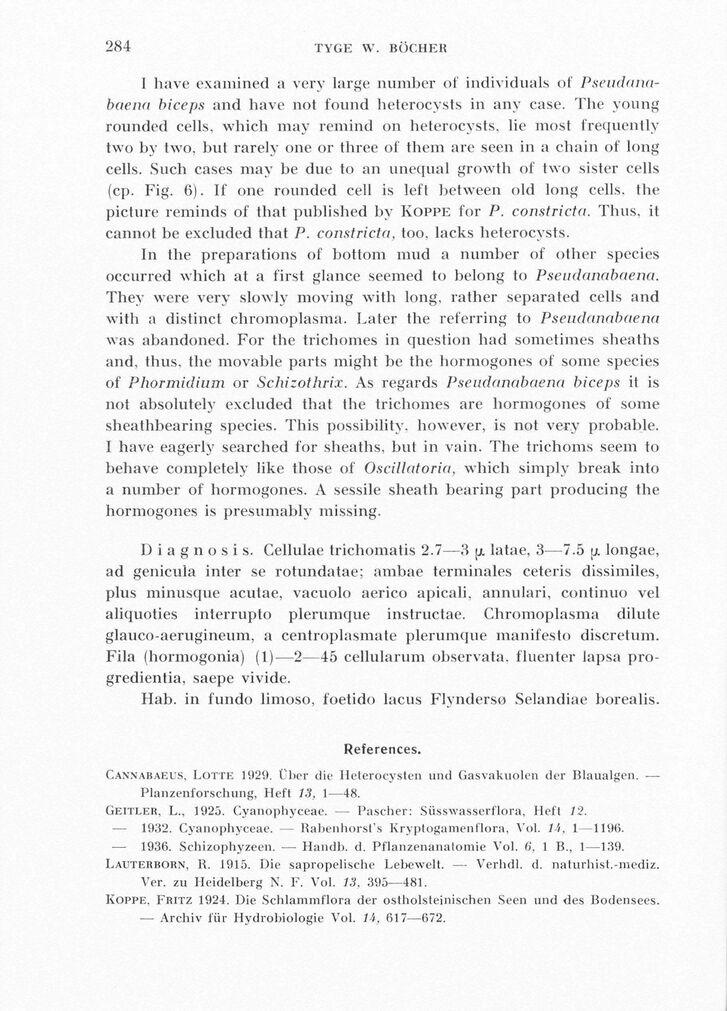
Full resolution (JPEG) - On this page / på denna sida - Sidor ...

<< prev. page << föreg. sida << >> nästa sida >> next page >>
Below is the raw OCR text
from the above scanned image.
Do you see an error? Proofread the page now!
Här nedan syns maskintolkade texten från faksimilbilden ovan.
Ser du något fel? Korrekturläs sidan nu!
This page has never been proofread. / Denna sida har aldrig korrekturlästs.
2K4
TYGE W. BÖCHEK
1 liave examined a verv large number of individuals of
Pseudana-baena biceps and have not found heterocysts in any case. The young
rounded cells, which may remind ön heterocysts, lie most frequently
two by two, but rarely one or three of theni are seen in a chain of long
cells. Such cases may be due to an unequal growth of two sister cells
(cp. Fig. 6). lf one rounded cell is lef t between old long cells, the
picture reminds of that published bv Koppe for P. constricta. Thus, it
cannot be excluded that P. constricta, too. lacks heterocysts.
In the preparations of bottom mud a number of other species
occurred which at a first glance seemed to belong to Pseudanabaena.
They were verv slowly moving with long, rather separated cells and
with a distinct chromoplasma. Låter the referring to Pseudanabaena
was abandoned. For the trichomes in question had sometimes sheaths
and, thus, the movable parts might be the hormogones of sorne species
of Phormidium or Schizothrix. As regards Pseudanabaena biceps it is
not absolutely excluded that the trichomes are hormogones of some
sheathbearing species. This possibility. however, is not verv probable.
I have eagerly searched for sheaths, but in vain. The trichoms seem to
behave completely like those of Oscillatoria, which simply break into
a number of hormogones. A sessile sheath bearing part producing the
hormogones is presumably missing.
D i a g n o s i s. Cellulae trichomatis 2.7—3 [jl latae, 3—7.5 f* longae,
ad genicula inter se rotundatae; ambae terminales ceteris dissimiles,
pius minusque acutae, vacuolo aerico apicali, annulari, continuo vel
aliquoties interrupto plerumque instructae. Chromoplasma dilute
glauco-aerugineum, a centroplasmate plerumque manifesto discretum.
Fila (hormogonia) (1)—2—45 cellularum observata, fluenter lapsa
pro-gredientia, saepe vivide.
Hab. in fundo limoso, foetido lacus Flyndersø Selandiae borealis.
References.
Cannabaeus, Lotte 1929. über die Heterocysten und Gasvakuolen der Blaualgen. •—
Planzenforschung, Heft 13, 1—48.
Geitler, L., 1925. Cyanophyceae. — Pascher: Süsswasserflora, Heft 12.
— 1932. Cyanophyceae. — Rabenhorst’s Kryptogamenflora, Vol. 14, 1 —1196.
— 1936. Schizophyzeen. — Handb. d. Pflanzenanatomie Vol. 6, 1 B., 1—139.
Lauterborn, r. 1915. Die sapropelische Lebewelt. — Verhdl. d. naturhist.-mediz.
Ver. zu Heidelberg N. F. Vol. 13, 395—481.
Koppe. Fritz 1924. Die Schlammflora der ostholsteinischen Seen und des Bodensees.
— Archiv für Hydrobiologie Vol. 14, 617—672.
<< prev. page << föreg. sida << >> nästa sida >> next page >>